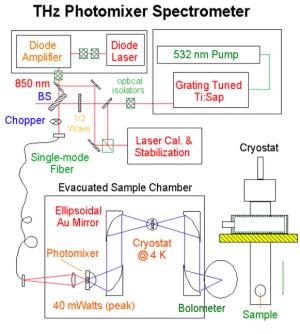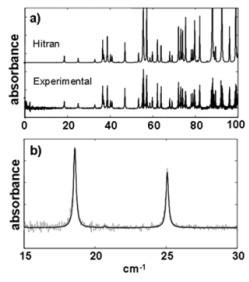Continuous-wave terahertz spectrometer

The continuous-wave terahertz spectrometer makes use of two near-infrared lasers. The first laser is a fixed-frequency cw ring Ti:Saph laser operating near 840 nm with a resolution of Δvlinewidth ≈ 0.00003 cm-1. The second laser is an in-house-built broadly tunable, standing-wave Ti:sapphire laser (Δvlinewidth ≈ 0.01 cm-1). The two laser beams are combined and focused onto a low-temperature-grown Er:GaAs photomixer (64 μm2) to generate a maximum of ≈ 5 µW of terahertz radiation from 0.06 THz (2 cm-1) to 4 THz (133 cm-1). Beyond the peak power at 0.6 THz, the output power decreases as ω-4. The focused terahertz beam passes through the cryogenically cooled sample or waveguide assembly at 4.2 K and is detected by a liquid-helium-cooled, silicon-composite bolometer. Power detection sensitivity of the bolometer is < 1 nW up to 3 THz in a 400 Hz bandpass (NEP of the bolometer is 1 pW/Hz1/2). Both the amplified bolometer signal and a voltage proportional to the photomixer current are sampled using lock-in amplifiers. These signals are oversampled at a rate 5 times faster than the 30 ms time constant of the bolometer to eliminate lineshape distortion. The Ti:sapphire frequency is measured at 200 Hz to an accuracy of 0.002 cm-1.

A spectrum calculated using the HITRAN database is compared to one obtained using the terahertz spectrometer.
These pressure broadened water lines (ΔνFWHM ≈ 0.2 cm-1) illustrate the scan-to-scan repeatability of the spectrometer, which is made possible by seeding the Ti:sapphire laser with a feedback from an external grating-tuned cavity through a 4% output coupler.

